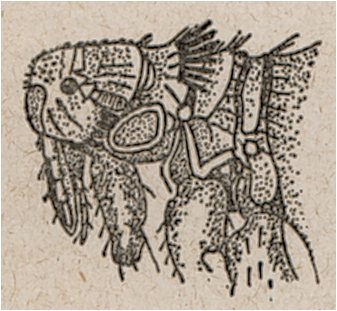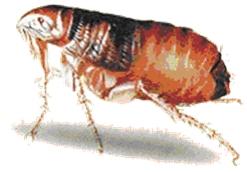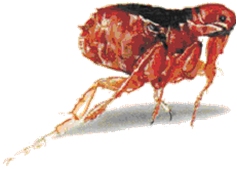Fleas and
Rabbits
Esther van Praag Ph.D.
MediRabbit.com is
funded solely by the generosity of donors.
Every
donation, no matter what the size, is appreciated and will aid in the
continuing research of medical care and health of rabbits.
Thank you
|
Fleas
can plague rabbits as well as humans. Wild rabbits are mainly infested by the
rabbit flea Spilopsyllus cuniculi.
The lifecycle of Spilopsyllus cuniculi
is synchronized to the lifecycle of the wild rabbit in such a way that eggs
are laid after the birth of newborn rabbits. The female flea deposits her
eggs inside the nest, where the necessary humidity is present for their
development. The survival of the hatched larvae can only happen when humidity
is higher than 50%. They feed on the feces of the adult fleas, which are rich
in blood sucked from the host.
The
flea population infesting a rabbit is composed of eggs (50%), larvae (35%),
pupas (10%) and only 5% adults. The development of the fleas is quick and
will infest new rabbits.
The
length of the lifecycle depends on the humidity of the air and the
temperature. In general it lasts between 12 and 14 days, but can take as
long as 6 months. Inside a house or an apartment, the complete life cycle
takes between 9 days and 4 weeks’ time.
Various
species of fleas have been found on rabbits. They include Pulex
irritans, Cediopsylla
simples, Odontopsyllus multispinosus, Echinnophaga
gallinacea, or Echidnophasis
mymecobil. Domestic rabbits are commonly
infested by the cat or dog fleas: Ctenocephalides
felis or Ctenocephalides
canis, respectively. The
presence of Ctenocephalides felis can cause serious irritation in animals and
man. It may be couple with an allergic reaction against the anti-coagulase
enzyme present in the injected saliva of the flea. This enzyme is necessary
to keep the fleabite open to allow a continuous flow of fresh blood to the
flea.
Fleas can be carrier of
contagious diseases, e.g., myxomatosis, or
tularemia, and of tapeworm species specific to the rabbit. The rabbit flea Spilopsyllus cuniculi can transmit
dangerous diseases or parasites affecting the wild rabbit population to pet
rabbits, such as the viral agent causing myxomatosis or the rabbit protozoan
parasite Trypanosoma nabiasi. Clinical
signs and diagnosis
The presence of fleas is typically
subclinical and seasonal, with a peak observed at the end of the summer.
Infestation is characterized by the presence of the feces of the fleas and
their eggs in the fur, or on a flea comb.
The
presence of fleas is frequently observed at the periphery of the ears,
between them, on the eyelids or the nose of the rabbit. Other locations on
the body should nevertheless not be ruled out. In rare cases, a strong
allergic reaction against the saliva injected by the flea takes place. If
such a reaction is observed, it is recommended to examine the rabbit for
further skin disease. The
presence of Spilopsyllus cuniculi
often leads to pruritic skin and the appearance of crusts. Fleabites
can be accompanied by secondary bacterial infections. Systemic antibiotics
are indicated. A bacterial culture, followed by a sensitivity test, will help
determine the best antibiotic option. Treatment
It
is important to treat both the rabbit infested by fleas, other pet animals in
the household, and the environment. Fleas
are eliminated by sprays, powder products or topical products: • pyrethrin based products. • selamectin: Revolution® (US) or
Stronghold® (Europe) - Pfizer, 18 mg/kg. A single topical (local) dose should
be sufficient; if not, repeat in 30 days. • imidacloprid: Advantage® -
Bayer, one single application is generally sufficient to remove the fleas. If
this is not the case, the treatment can be repeated after 30 days. The vapors
of this product can lead to irritation of the eyes; it is thus recommended to
aerate the room where the rabbit lives in. • lufenuron: Program® - Novartis,
10 mg/kg. One sole treatment should be sufficient. If not, the treatment can
be repeated after 30 days. Impregnated anti-flea collars
should never be used in rabbits. They lead to severe irritation and burning of
the skin. There are reported cases, where the rabbit attempted to remove its
collar, and died as a result of jamming its jaw in the collar. Treatment of the environment is important
(boric acid such as Fleabusters®; Vet-Kem Acclaim Plus® - Sanofi; Staykil®
- Novartis; Indorex® - Virbac;
acaricide spray). When treating a carpet, vacuum
first in order to further penetration of the spray or powder. Shampooing and
steam cleaning are not ideal; their residual humidity can increase the mite
problem. During treatment of the environment, rabbits should be kept in
another part of the home to avoid the danger of contact with the products. For detailed information on flea infestation in
rabbits, see: “Skin Diseases of Rabbits”, by E. van Praag, A. Maurer and
T. Saarony 408
pages, 2010. Further
Readings
Amin OM.
Comb variations in the rabbit flea, Cediopsylla
simplex (Baker). J Med Entomol. 1974;11:227-230. Farlow JE,
Burns EC, Newsom JD. Seasonal distribution of some arthropod parasites of
rabbits in Louisiana. J
Med Entomol. 1969;6:172-174. Graves
GN, Bennett WC, Wheeler JR, Miller BE, Forcum DL. Sylvatic plague studies in southeast New Mexico.
II. Relationships of the desert cottontail and its fleas. J Med Entomol. 1978;14:511-522. Gurycova
D. First isolation of Francisella tularensis subsp. tularensis
in Europe. Eur J Epidemiol.
1998; 14:797-802. Hutchinson
MJ, Jacobs DE, Bell GD, Mencke N. Evaluation of imidacloprid for the treatment and prevention of cat flea
(Ctenocephalides felis
felis) infestations on rabbits. Vet Rec. 2001;
148(22):695-696. Launay
H. On the phenology of the flea Xenopsylla
cunicularis Smit, 1957 (Siphonaptera,
Pulicidae) parasite of the European rabbit. Ann Parasitol Hum Comp. 1982;57(2):145-163. Mead-Briggs
AR, Vaughn JA, Rennison BD. Seasonal variation in
numbers of the rabbit flea on the wild rabbit. Parasitology. 1975;70(1):103-118. Merchant JC, Kerr PJ, Simms NG, Robinson AJ. Monitoring the spread of myxoma
virus in rabbit Oryctolagus cuniculus populations on the southern
tablelands of New South Wales, Australia. I. Natural occurrence
of myxomatosis. Epidemiol Infect. 2003;
130(1):113-121. Osacar-Jimenez
JJ, Lucientes-Curdi J, Calvete-Margolle C. Abiotic factors influencing the
ecology of wild rabbit fleas in north-eastern Spain. Med Vet Entomol. 2001;15(2):157-66. Osacar
JJ, Lucientes J, Calvete
C, Peribanez MA, Gracia
MJ, Castillo JA. Seasonal abundance of fleas (Siphonaptera:
Pulicidae, Ceratophyllidae)
on wild rabbits in a semiarid area of northeastern Spain. J Med Entomol. 2001; 38(3):405-410. Pfaffenberger
GS, Valencia VB. Ectoparasites of sympatric
cottontails (Sylvilagus audubonii Nelson)
and jack rabbits (Lepus californicus Mearns)
from the high plains of eastern New Mexico. J Parasitol.
1988; 74(5):842-6. Pinter L. Leporacarus gibbus
and Spilopsyllus cuniculi infestation
in a pet rabbit. J Small Anim Pract.
1999; 40(5):220-221. Rothschild
M. Myxomatosis and the rabbit flea. Nature. 1965;
207(2):1162-1163. Shepherd
RC. Myxomatosis: the occurrence of Spilopsyllus cuniculi (Dale) larvae on dead
rabbit kittens. J Hyg (Lond).
1978; 80(3):427-9. Timm
KI. Pruritus in rabbits, rodents, and ferrets. Vet Clin
North Am Small Anim Pract.
1988; 18(5):1077-91. Vashchenok VS, Shuliat'ev AA. Spilopsyllus cuniculi fleas--parasites of
the wild rabbit on the territory of the USSR. Parazitologiia.
1990; 24(2):148-51. |
e-mail: info@medirabbit.com










